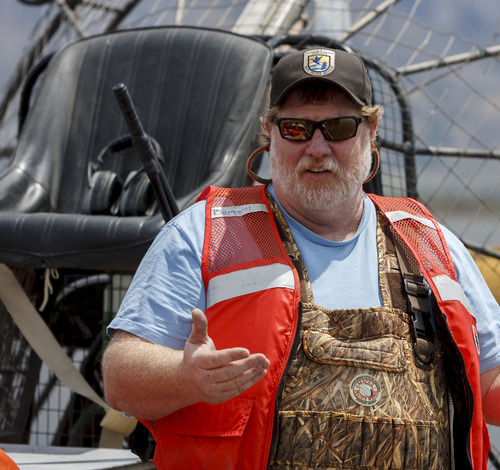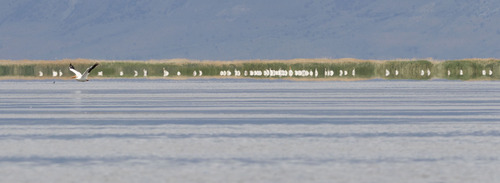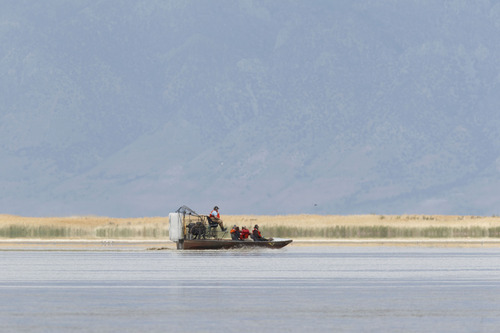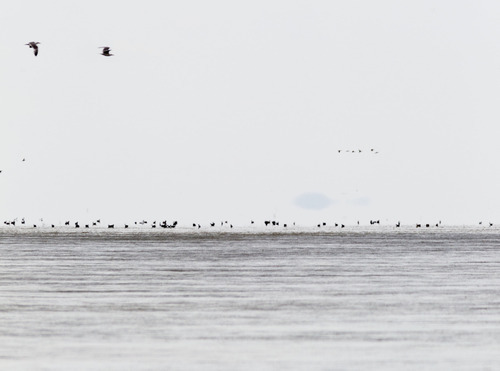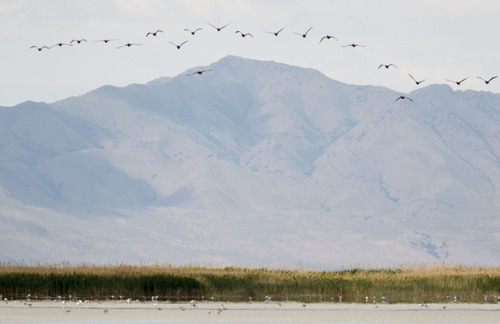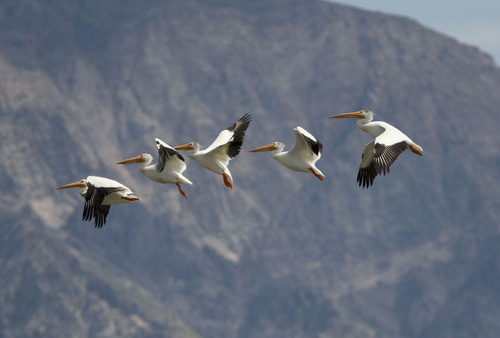This is an archived article that was published on sltrib.com in 2012, and information in the article may be outdated. It is provided only for personal research purposes and may not be reprinted.
They gathered in airboats off the northeastern corner of the Great Salt Lake shoreline. Above, clouds jostled in the vast Utah sky.
Around them, marsh grass teemed with life — White-faced Ibis, white pelicans, Snowy Egrets, Marbled Godwits and innumerable bird cousins darted across the horizon, splashed into the water and otherwise busied themselves with migration chores during a rest and refueling stop at the Willard Spur. The lake itself exhaled warm, earthy breaths.
Here, in the middle of wetland wilderness, members of Utah's Water Quality Board could fully grasp the challenge ahead: learning how humans are affecting this one-of-a-kind ecosystem — and someday determining how to protect it for the future.
"It's a different perspective that you get out here," said Walt Baker, director of the Utah Division of Water Quality and executive secretary of the board. "It's part of our heritage. It's what we're about and, frankly, I think we all have a stake in the lake."
This will be the second season of data-gathering at the 25-square-mile area known as the Willard Spur, a freshwater oasis just downstream of the $28 million Willard-Perry wastewater treatment plant.
Scientists are studying samples of the water itself, said Jim Harris of the state's clean-water office. They're also assessing the birds that use the wetlands. They are testing water, sediment and tissue from wildlife for signs of contamination by heavy metals and even chemicals from the Bear River.
To make good decisions about the lake, the board wants to understand what happens to pollutants — especially fertilizers, street runoff and treated sewage — when they enter the wetlands.
It's a difficult job because most of the Great Salt Lake — which does not provide drinking water — is in a category of its own. Pollution standards for the state's other lakes and streams simply don't apply here except in a few waterfowl management areas where fresh water flows.
So far, the only pollution limit on the Great Salt Lake is for selenium in a small area of wetlands at the lake's southern end.
Last month, the water board unveiled a strategy for protecting the water quality on the entire 1,699-square-mile lake that will rely in part on the Willard Spur findings.
Bob Barrett, a burly man who manages the Bear River Migratory Bird Refuge, organized the visit Wednesday. He told water board members that explorer John Fremont made note of this spot more than 150 years ago, commenting that the birds' fluttering wings sounded like "distant thunder."
Seventy species of birds rely on the wetlands, and hundreds of thousands of them pass through each year.
"Our message is: This is a special place," said Barrett. "I wish I could get everyone in the state of Utah out to see this."
Barrett, who calls the lake "the Yellowstone of the national wildlife refuge system," describes it as an extraordinary natural resource — not just for Utah but the world. A recent study showed the lake pumps $1.3 billion into the economy each year from salt, magnesium, brine shrimp eggs, recreation and other industries. And last year, some 200,000 tourists visited from 31 countries.
"They come up here and go 'wow,' " Barrett said. "Those countries don't have the vast landscape we have here."
Impetus for the $1.4 million study came from the Utah Waterfowl Association, the Utah Air Boat Association and other conservation groups that challenged regulators over allowing the wastewater plant to begin discharging into the spur last year before knowing how it would affect pollution in the bay. They settled the quarrel by working together on a discharge permit that, among other things, requires the study.
Eventually a science advisory panel and a steering committee will examine a full range of water-quality issues on the lake. Participants will include the refuge, U.S. Fish and Wildlife Service, the U.S. Geological Survey and Utah State University, which already have done a lot of research on the lake.
Merritt Frey, a member of the water board and habitat director for the River Network, said the Great Salt Lake studies and planning will allow the board to get ahead of any pollution threatening the lake.
"The partnership gives us an opportunity to make informed decisions," she said. "That's a hopeful message."
From his seat on the air boat about four miles into the study area, Baker took it all in. The birds, the big sky, the seemingly endless puddle that stretches 75 miles long and 35 miles wide.
"The Great Salt Lake and the wetlands have been ignored for too long, taken for granted for too long," he said. "There's a quietness and sacredness. The value is incalculable."
fahys@sltrib.comTwitter: @judyfutah


